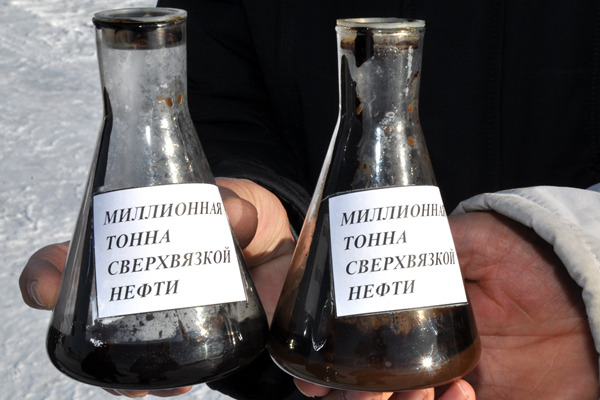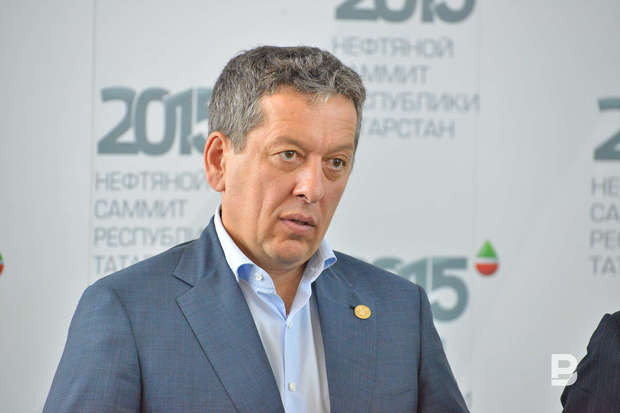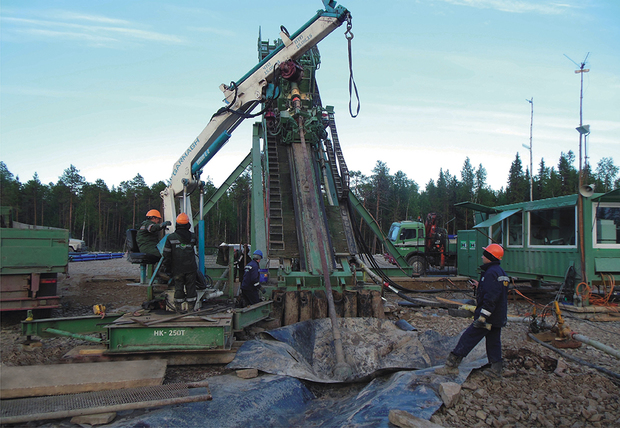Goodbye, bitumen: cheap barrel forced Tatneft to suspend the production of extra-viscous crude oil
As it became known to Realnoe Vremya, due to the fall in oil prices Tatneft suspended indefinitely the further development of Ashalchinskoye field of extra-viscous oil, extraction of which is carried out in the framework of preferential federal tax treatment '10-10-10'. All oilfield services companies, attracted to increase fund of oil wells, stopped drilling works at the request of oil companies.
The drillers were 'asked to leave' after the extraction of the first million
As it became known to Realnoe Vremya from its sources, at the beginning of March, the drilling works have been suspended at all eight oilfield services companies, worked on the terms of contractual agreements with entities PJSC Tatneft, at several sites of Ashalchinskoye field of extra-viscous oil (EVO) in the South-East of the Republic. Among them are departments of Tatarstan trust company Tagras-Holding, Russian SP VIS-MOS, which is one of the largest drilling companies operating with the use of trenchless technology. According to the representative of one of the contractors, the termination of work was by the oral order of Tatneft.
'We were told that the development and production of EVO are beneficial for Tatneft only if the cost of oil at $46 per barrel (oil is already below $40 – editor's note), therefore, further drilling of the oilfield at low prices does not seem reasonable,' he said, adding that previously signed long-term contracts 'have not cancelled'. This information was confirmed in the administration of one of Kazan companies, which is the supplier of special drilling rigs with slanted mast. 'Yes, all contractors terminated the works — those who built two wells and those who built 22 wells. Fortunately, all of our delivery equipment had been paid,' said its Director General. The representative of oil and gas management Nurlatneft, which extracts oil in this field, confirmed to Realnoe Vremya that the drillers have really stopped working. But only in the far areas of the oilfield that were supposed to develop in the prospect.
The official request of Realnoe Vremya in a press-service of Tatneft has remained unanswered. It is not surprising, because none of the participants of the landmark project on the development of EVO didn't seek to disclose such an unexpected turn of events in the Ashalchinskoye oilfield. Just at the end of February, the oilers celebrated the extraction of first million tonnes of oil since the beginning of the oilfield development in 2006. 'Over the years tens of technologies have been tested, valuable experience of development of easy-to-recover oil reserves has been accumulated. Daily production is more than 1 300 tonnes,' states the message of Tatneft, released on 25 February of this year.
Moreover, the representatives of Tatneft have recently announced an excessive grow of oil production to 2.5 million tonnes by 2018. 'We are planning to increase due to an intensive drilling and development of deposits of Ashalchinskoye field, and there are a lot of uplifts. We managed to invest in capital construction – drilling, building of pipelines, water conduit, the construction of steam generators – until the sharp drop in prices' told to Realnoe Vremya the head of the drilling department of the Institute TatNIPIneft Farit Akhmadishin at the conference of the members of the International Association of Specialists for Horizontal Directional Drilling (HDD MAC) in Kazan. On the background of optimistic statements, the news of the termination of drilling sounded like a bolt from the blue.

Federal pill '10-10-10' doesn't save?
Ashalchinskoye field of natural bitumen is the largest one in the country in terms of reserves of EVO (up to 7 billion tonnes) and, therefore, it was chosen as a pilot area of Russia on the development of innovative technologies in its production. The second major field of EVO in the country is Yaregskoye in Komi Republic (developed by Lukoil). For its profitable development, the federal government met halfway the joint initiative of Tatneft and Lukoil on the creation of favorable tax regime. Since 2007, in accordance with the Federal law №151-FZ from 27 June 2006, they introduced the zero rate of the tax on mineral extraction (NDPI) for horizons of extra-viscous oil that still applies in the Ashalchinskoye field. From 1 July of 2012, following the meeting of the government Commission on the fuel and energy complex new concessions have been granted — on the export duties, which are called '10-10-10'. In other words, for the oilfields with the viscosity not less than 10 thousand centipoises [*] within 10 years there will operate a preferential export duty rate – 10% of normal.
As a major organizer and investor of development of deposits of heavy (bitumen) oil of Permian system, Tatneft has invested a lot. According to the Director General of Tatneft Nail Maganov, in 2013, 1.2 billion rubles were invested in drilling at the pilot site, almost 1.8 billion rubles – in its arrangement. 'In 2015, Ashalchinskoye field will be fully drilled and they will start work on the North-Ashalchinskoye field. At the end of 2013, the programme on the study of extra-viscous oil was adopted, additional funds for exploration has been allocated for geological research,' he said, promising that 100 billion rubles will be investedin order to accelerate the development of bitumen deposits by 2018. Meantime, as follows from the report, in 2015 Tatneft received saved money from the lower amount of tax on mineral extraction (NDPI) at 28.5 billion rubles, of which 4.2 billion — from benefits in the extraction of extra-viscous oil at Ashalchinskoye and other fields.

'Tatneft started to develop Ashalchinskoye field with the oil price at $100 per barrel, and although they failed to create a joint venture with SHELL, they managed to start production,' explains the analyst of Sberbank CIB Valery Nesterov, adding that this year many Russian companies have suspended the commissioning of new fields. According to him, in recent years, Tatneft was actively increasing the pace of drilling on its fields, becoming the absolute leader by the end of 2015 (an increase of 137%), while Lukoil reduced by nearly 40%. Deputy head of drilling and repair of wells of the oil and mine management Yareganeft PLC Lukoil-Komi Sergey Chen told Realnoe Vremya that due to the fall in oil prices 'investments have also decreased, production has decreased, drilling activity have decreased'. 'Today we produce 670 thousand tonnes of oil, and the planning horizon – 3.5 million tonnes by 2022,' he said.
Easy-to-recover oil lays not deep
The difficulty in developing EVO in the Ashalchinskoye field is that the reserves of deposits are small and are at shallow depths (up to 200 meters), 'scattered on the territory, which complicates the effective development'. According to experts, EVO is considered to be easy-to-recover because 'at more depths, you can use the vertical oil drilling rigs, at extremely small (100 to 200 meters) it is very difficult to do. And here, MDD-rigs are best suited that allow you to drill wells very close to the surface (up to 100 meters)'.
Due to that reason, Tatneft was forced to attract those contractors, who master professionally the technology and equipment of horizontal directional drilling. As the representative of oil and gas management Nurlatneft stated, in total 269 wells have been drilled on the field, which provide stable production at over 1 000 tonnes per day. More than 300 wells are needed to reach the level of 2.5 million tonnes. So, the oilers are still waiting for a production increase of EVO, and the contractors hope to get back to implement the signed contracts. Only the timing of the resumption of the work remains completely unclear.

[*] Centipoise – a cgs unit of measure of absolute viscosity.
Reference
Development of Natural Bitumen Fields
Tatarstan Republic possesses significant reserves of heavy and extra viscous bituminous oils (over 1.4 billion tonnes). About 450 deposits have been identified with majority of them confined to the depth of 50-250 m.
Since 2006, JSC TATNEFT has initiated a pilot project at Ashalchinskoye field to test a modified heat stimulation technology through dual wellhead horizontal wells. (Patent of the Russian Federation Number 2287677). There are three pairs of double wellbore wells at the site with a horizontal section length from 200 to 400 meters.
According to the Company's plans to develop extra-viscous oil fields, pilot works were carried out in the Sheshminsky horizon deposits of Ashalchinskoye heavy oil field in 2013.
Location of Horizontal Day Drift Wells
A method had been developed to control the process of steam assisted gravity stimulation using dual head horizontal wells, providing for creation of the steam chamber and uniform heating of the interwell area, preventing steam breakthrough into producing wells from steam injectors and maximizing oil production at an optimal steam-oil ratio (RF patent №2340768). The site includes three pairs of dual head wells with a horizontal section of 200 to 400 m long.
Implementation of the technology demonstrated the works prospectivity: horizontal wells produce up to 20 tonnes per day (with an average production rate of conventional oil wells amounting to 4 tonnes per day), which is 8 to 10-fold higher than in case of vertical wells.
56 horizontals, including 5 single horizontal wells for the huff-and-puff technology application were drilled at Ashalchinskoye EVO field. Construction of 19 wells was completed in 2013. There are 19 horizontal wells pairs in operation.
The daily oil production reached 480 tonnes by the end of the year. The amount of 145.616 thousand tonnes of oil was produced in 2013, which is 2 times more than in the previous year. The total production since the beginning of the EVO field pilot development amounted to 325.683 thousand tonnes of oil.